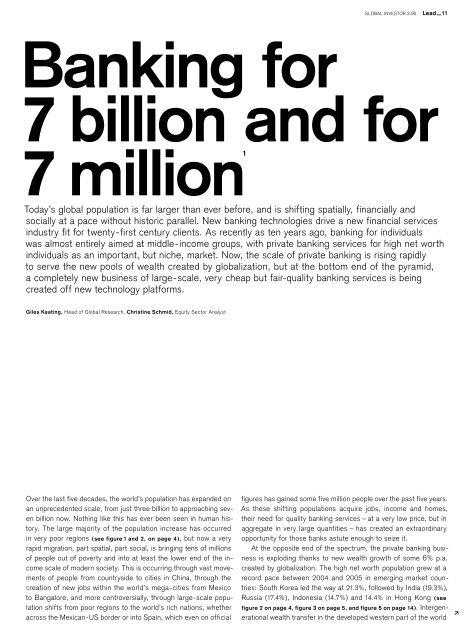Banking for 7 billion and 7 million
New challenges and opportunities of globalization Global Investor, 03/2006 Credit Suisse
New challenges and opportunities of globalization
Global Investor, 03/2006
Credit Suisse
Create successful ePaper yourself
Turn your PDF publications into a flip-book with our unique Google optimized e-Paper software.
GLOBAL INVESTOR 3.06 Lead — 11<br />
<strong>Banking</strong> <strong>for</strong><br />
7 <strong>billion</strong> <strong>and</strong> <strong>for</strong><br />
7 <strong>million</strong>1<br />
Today’s global population is far larger than ever be<strong>for</strong>e, <strong>and</strong> is shifting spatially, financially <strong>and</strong><br />
socially at a pace without historic parallel. New banking technologies drive a new financial services<br />
industry fit <strong>for</strong> twenty-first century clients. As recently as ten years ago, banking <strong>for</strong> individuals<br />
was almost entirely aimed at middle-income groups, with private banking services <strong>for</strong> high net worth<br />
individuals as an important, but niche, market. Now, the scale of private banking is rising rapidly<br />
to serve the new pools of wealth created by globalization, but at the bottom end of the pyramid,<br />
a completely new business of large-scale, very cheap but fair-quality banking services is being<br />
created off new technology plat<strong>for</strong>ms.<br />
Giles Keating, Head of Global Research, Christine Schmid, Equity Sector Analyst<br />
Over the last five decades, the world’s population has exp<strong>and</strong>ed on<br />
an unprecedented scale, from just three <strong>billion</strong> to approaching seven<br />
<strong>billion</strong> now. Nothing like this has ever been seen in human history.<br />
The large majority of the population increase has occurred<br />
in very poor regions (see figure 1 <strong>and</strong> 2, on page 4), but now a very<br />
rapid migration, part spatial, part social, is bringing tens of <strong>million</strong>s<br />
of people out of poverty <strong>and</strong> into at least the lower end of the income<br />
scale of modern society. This is occurring through vast movements<br />
of people from countryside to cities in China, through the<br />
creation of new jobs within the world’s mega-cities from Mexico<br />
to Bangalore, <strong>and</strong> more controversially, through large-scale population<br />
shifts from poor regions to the world’s rich nations, whether<br />
across the Mexican-US border or into Spain, which even on official<br />
figures has gained some five <strong>million</strong> people over the past five years.<br />
As these shifting populations acquire jobs, income <strong>and</strong> homes,<br />
their need <strong>for</strong> quality banking services – at a very low price, but in<br />
aggregate in very large quantities – has created an extraordinary<br />
opportunity <strong>for</strong> those banks astute enough to seize it.<br />
At the opposite end of the spectrum, the private banking business<br />
is exploding thanks to new wealth growth of some 6% p.a.<br />
created by globalization. The high net worth population grew at a<br />
record pace between 2004 <strong>and</strong> 2005 in emerging market countries:<br />
South Korea led the way at 21.3%, followed by India (19.3%),<br />
Russia (17.4%), Indonesia (14.7%) <strong>and</strong> 14.4% in Hong Kong (see<br />
figure 2 on page 4, figure 3 on page 5, <strong>and</strong> figure 5 on page 14). Intergenerational<br />
wealth transfer in the developed western part of the world

















